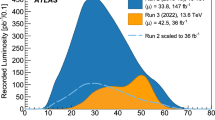Abstract
Heavy-ion collisions at NICA energies provide a unique opportunity for the study of the production of hypernuclei in dense baryonic matter. In this paper, the details of the reconstruction procedure for hypertritons with the MPD detector in Bi + Bi collisions at NICA energies are presented.







Similar content being viewed by others
REFERENCES
J. Rafelski and B. Muller, “Strangeness production in the quark-gluon plasma,” Phys. Rev. Lett. 48, 1066 (1982).
C. Alt et al. (NA49 Collab.), “Pion and kaon production in central Pb + Pb collisions at 20A and 30A GeV: Evidence for the onset of deconfinement,” Phys. Rev. C 77, 024903 (2008).
V. Koch, A. Majumder, and J. Randrup, “Baryon-strangeness correlations: A diagnostic of strongly interacting matter,” Phys. Rev. Lett. 95, 182301 (2005).
S. Zhang et al., “Searching for onset of deconfinement via hypernuclei and baryon-strangeness correlations,” Phys. Lett. B 684, 224 (2010).
J. M. Lattimer and M. Prakash, “The physics of neutron stars,” Science (Washington, DC, U. S.) 304, 536 (2004).
ALICE Collab., “\(_{\Lambda }^{3}{\text{H}}\) and \(_{{\bar {\Lambda }}}^{3}{{\bar {H}}}\) lifetime measurement in Pb–Pb collisions at \(\sqrt {{{s}_{{NN}}}} = 5.02\) TeV via two-body decay,” Phys. Lett. B 797, 134905 (2019).
V. Kekelidze, R. Lednicky, V. Matveev, et al., “Three stages of the NICA accelerator complex,” Eur. Phys. J. A 52, 211 (2016).
J. Steinheimer, K. Gudima, A. Botvina, et al., “Hypernuclei, dibaryon and antinuclei production in high energy heavy ion collisions: Thermal production vs. coalescence,” Phys. Lett. B 714, 85 (2012).
J. Aichelin, E. Bratkovskaya, A. le F’evre, V. Kireyeu, V. Kolesnikov, Y. Leifels, V. Voronyuk, and G. Coci, “Parton-hadron-quantum-molecular dynamics: A novel microscopic n-body transport approach for heavy-ion collisions, dynamical cluster formation, and hypernuclei production,” Phys. Rev. C 101, 044905 (2020).
W. Cassing and E. L. Bratkovskaya, “Parton-hadron-string dynamics: An off-shell transport approach for relativistic energies,” Nucl. Phys. A 831, 215 (2009).
J. Aichelin, “'Quantum' molecular dynamics—a dynamical microscopic n-body approach to investigate fragment formation and the nuclear equation of state in heavy ion collisions,” Phys. Rep. 202, 233 (1991).
R. K. Puri, C. Hartnack, and J. Aichelin, “Early fragment formation in heavy-ion collisions,” Phys. Rev. C. 54, R28 (1996).
T. Anticic et al. (NA49 Collab.), “Production of deuterium, tritium, and 3He in central Pb + Pb collisions at 20A, 30A, 40A, 80A, and 158A GeV at the CERN Super Proton Synchrotron,” Phys. Rev. C 94, 044906 (2016).
V. Golovatyuk, V. Kekelidze, V. Kolesnikov, et al., “The Multi-Purpose Detector (MPD) of the collider experiment,” Eur. Phys. J. A 52, 212 (2016).
K. Gertsenberger, S. Merts, O. Rogachevsky, and A. Zinchenko, “Simulation and analysis software for the NICA experiments,” Eur. Phys. J. A 52, 214 (2016).
Funding
This work was supported by the Russian Science Foundation, grant no. 19-42-04101. E. Bratkovskaya acknowledges support by the Deutsche Forschungsgemeinschaft (DFG, German Research Foundation): grant BR 4000/7-1. Furthermore, J. Aichelin and E. Bratkovskaya acknowledge the support from STRONG-2020 “The strong interaction at the frontier of knowledge: fundamental research and applications” which received funding from the European Union’s Horizon 2020 research and innovation programme under grant agreement no. 824093.
ADDITIONAL INFORMATIONThe study has been performed at the Laboratory of High Energy Physics, JINR.
Author information
Authors and Affiliations
Corresponding author
Rights and permissions
About this article
Cite this article
Kolesnikov, V.I., Kireyeu, V.A., Mudrokh, A.A. et al. Monte Carlo Studies of the MPD Detector Performance for the Measurement of Hypertritons in Heavy-Ion Collisions at NICA Energies. Phys. Part. Nuclei Lett. 19, 46–53 (2022). https://doi.org/10.1134/S1547477122010071
Received:
Revised:
Accepted:
Published:
Issue Date:
DOI: https://doi.org/10.1134/S1547477122010071




